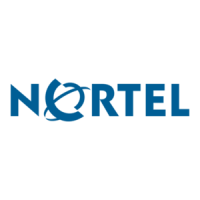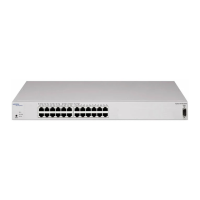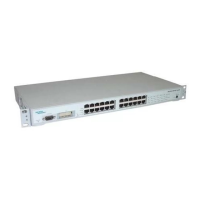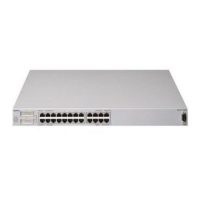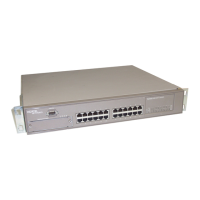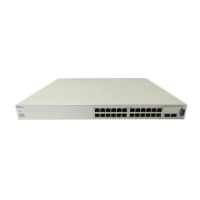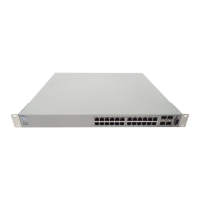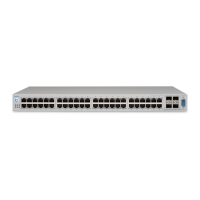Do you have a question about the Nortel 2526T and is the answer not in the manual?
Information about feature changes in the release.
Details on advanced EAPOL security features supported.
Guide intended for network administrators with specific background knowledge.
Explains text conventions used throughout the guide.
Information on obtaining technical support via the Nortel Web site.
How to contact specialists using an Express Routing Code.
Configure local or RADIUS password for management access or set SNMP community strings.
Provides three levels of LAN security: RADIUS, MAC, and EAPOL.
Network access control using RADIUS protocol for authentication.
Network access control based on authorized source MAC addresses.
Security based on Extensible Authentication Protocol over LAN (EAPOL).
Enhanced security for switch and stack passwords.
Supports SNMP for monitoring and changing device states.
Supports Multihost (MH) and Non-EAPOL hosts on EAPOL-enabled ports.
Secure the system using CLI commands for username, IP manager, Telnet, SSH, RADIUS, SNMP.
Secure the network using CLI commands for MAC address and EAPOL-based security.
Set and view EAPOL security information for the switch.
Lists boards, ports, and MAC addresses with security configuration.
Displays authorized boards and port status data collection.
Displays parameters available for SSH configuration.
Configure primary and secondary RADIUS server settings.
Configure additional EAPOL-based security parameters for ports.
Details on SNMPv3 architecture, security models, and configuration.
Steps to build and manage security using the Web-based management interface.
Set Console, Telnet, and Web passwords using the web interface.
Log on to the Web-based management interface after setting passwords/RADIUS.
Specify system responses to unauthorized network access using MAC addresses.
Configure SNMPv1 community strings, trap mode, and autotopology settings.
Build and manage SNMPv3 using the Web-based management user interface.
Lists supported standard and proprietary SNMP MIBs for the switch.
Describes supported industry standard and proprietary SNMPv1 traps.
Information about feature changes in the release.
Details on advanced EAPOL security features supported.
Guide intended for network administrators with specific background knowledge.
Explains text conventions used throughout the guide.
Information on obtaining technical support via the Nortel Web site.
How to contact specialists using an Express Routing Code.
Configure local or RADIUS password for management access or set SNMP community strings.
Provides three levels of LAN security: RADIUS, MAC, and EAPOL.
Network access control using RADIUS protocol for authentication.
Network access control based on authorized source MAC addresses.
Security based on Extensible Authentication Protocol over LAN (EAPOL).
Enhanced security for switch and stack passwords.
Supports SNMP for monitoring and changing device states.
Supports Multihost (MH) and Non-EAPOL hosts on EAPOL-enabled ports.
Secure the system using CLI commands for username, IP manager, Telnet, SSH, RADIUS, SNMP.
Secure the network using CLI commands for MAC address and EAPOL-based security.
Set and view EAPOL security information for the switch.
Lists boards, ports, and MAC addresses with security configuration.
Displays authorized boards and port status data collection.
Displays parameters available for SSH configuration.
Configure primary and secondary RADIUS server settings.
Configure additional EAPOL-based security parameters for ports.
Details on SNMPv3 architecture, security models, and configuration.
Steps to build and manage security using the Web-based management interface.
Set Console, Telnet, and Web passwords using the web interface.
Log on to the Web-based management interface after setting passwords/RADIUS.
Specify system responses to unauthorized network access using MAC addresses.
Configure SNMPv1 community strings, trap mode, and autotopology settings.
Build and manage SNMPv3 using the Web-based management user interface.
Lists supported standard and proprietary SNMP MIBs for the switch.
Describes supported industry standard and proprietary SNMPv1 traps.
| Model | 2526T |
|---|---|
| Ports | 24 |
| Uplink Ports | 2 |
| Layer | Layer 2 |
| Power Supply | Internal |
| Manageable | Yes |
| Switching Capacity | 8.8 Gbps |
| Forwarding Rate | 6.5 Mpps |
| Jumbo Frame Support | Yes |
| Type | Managed |
| Features | VLAN, QoS |
| Form Factor | Rack Mount |
| MAC Address Table Size | 8K entries |
| Operating Temperature | 0 °C to 40 °C |
| Storage Temperature | -40°C to 70°C |
| Operating Humidity | 10% to 90% (non-condensing) |
| Storage Humidity | 10 - 95% (non-condensing) |
